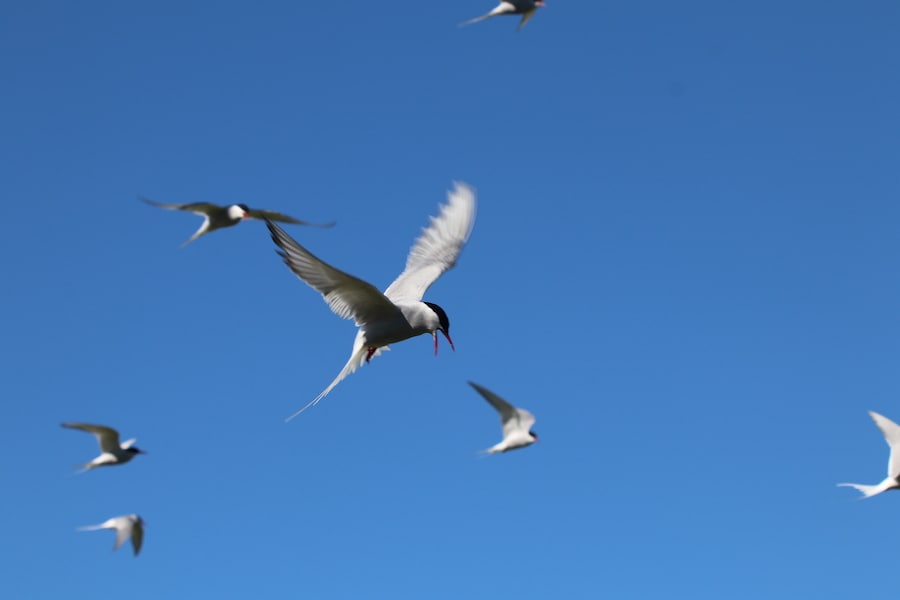Today is National Bird Day and we’re thrilled to celebrate the work of our National Geographic Live Speaker, British biologist and animal tracking expert Lucy Hawkes. In honor of this high-flying day, I had an opportunity to speak with Lucy about her work and what she has learned following these dinosaur relatives around the world and back.
As a physiological ecologist, Lucy has electronically tagged and tracked birds – and turtles, sharks, fish, and more. What is a physiological ecologist you might ask? Simply put as Lucy says, her job is to understand animals in their natural habitats. During her show, “Life on the Move,” she shares information about these amazing airborne athletes and their magnificent fetes defying gravity as they travel the planet to complete their great migratory patterns.

Lucy loves seeing the world both during fieldwork and through these animals’ eyes. Her stories bring you on a global journey from the front lines of exploration and offer a fun and educational adventure – right from the comfort of your theatre seat when you see her in-person. Here are six amazing fun bird facts she shared with us:
- If you’re a bird, within weeks of being born you may travel halfway around the planet. Arctic terns, a small and slender white bird with angular wings, travel from the North Pole to the South Pole and back, every year. “They’re not Olympic birds or special athletes like we think of today – they are not a celebrity – these birds are normal animals, and it is a normal part of their life.”
- Sea swallows travel over 62,000 miles per year and fly enough to go to the moon and back about six times in their life span. Sea swallows (another name for Arctic terns) live approximately three decades, nest around the North Pole – in Iceland, Alaska, Scandinavia, and Russia – and then journey to Antarctica. They’ll occasionally do a side trip to Australia but then head north again.
- Some birds can fly over Mount Everest. The high-flying Asian bar-headed goose whose migratory route involves more than 3,000 miles of flight over 90 days across the Himalayas, migrates twice a year, and can soar over mountain summits that scrape the sky at 29,000 feet.
- A Bar-tailed Godwit, with striped bars on its tail plume, boasts the record of the longest documented non-stop journey of any known animal, traveling from Alaska to New Zealand. In one of the most extreme trips on earth, this marathon bird flies for at least one week and does not eat, drink nor rest along the way. After plumping up, the bar-tailed Godwit utilizes every ounce of energy, body fat and muscle to push boundaries and keep flying. Upon arriving, they weigh approximately half of what they did upon leaving just to stay alive for the trans-ocean trek. “Imagine a human doing that!”
- Birds have small, unidirectional lungs with reservoirs that fill like balloons to help them fly. Unlike humans, birds’ breathing air always moves in one direction. Once air is inhaled, it is not recirculated. The air sacs surrounding the lungs allow for continuous fresh air, which helps them fly.
- Birds time their northward migration patterns to the first blooms of spring: In the springtime, the first vegetation that blooms is particularly rich in protein, so birds time their northward migrations to arrive at this banquet just as the food is at its best. Birds will follow this “green wave” all the way to their breeding grounds.
Lucy’s most memorable bird encounter she recalled was in Mongolia, where she caught a bar-headed goose, that she had miraculously tagged in India over two years earlier with a unique tracking tag.

When it comes to traveling to capture these magnificent creatures of flight, she cannot live without her amazing inflatable air mattress with a built-in pump, a secret stash of dried mangoes, chocolates or peanuts, and of course, her field notebook and binoculars.
Whether you are new to birding and love hearing seagulls from “Finding Nemo” say “MINE!,” or are keen on competing for a big year title amongst the country’s best birders who seek to identify as many species of birds possible in one calendar year, Lucy hopes guests come away from her shows learning one thing: “I would love it if people could look at birds like they do celebrities – like I do. That’s not just a pigeon, it’s an athlete. I hope they’ll stop and say that there are some interesting facts about these animals that they didn’t realize.”
To see where you can spot Lucy in the coming months or learn more about National Geographic Live and our upcoming events, visit our website.


Comments
I see children chasing birds at WDW all the time. Maybe have CMs remind guests that’s not a good thing to do?
Comments are closed.